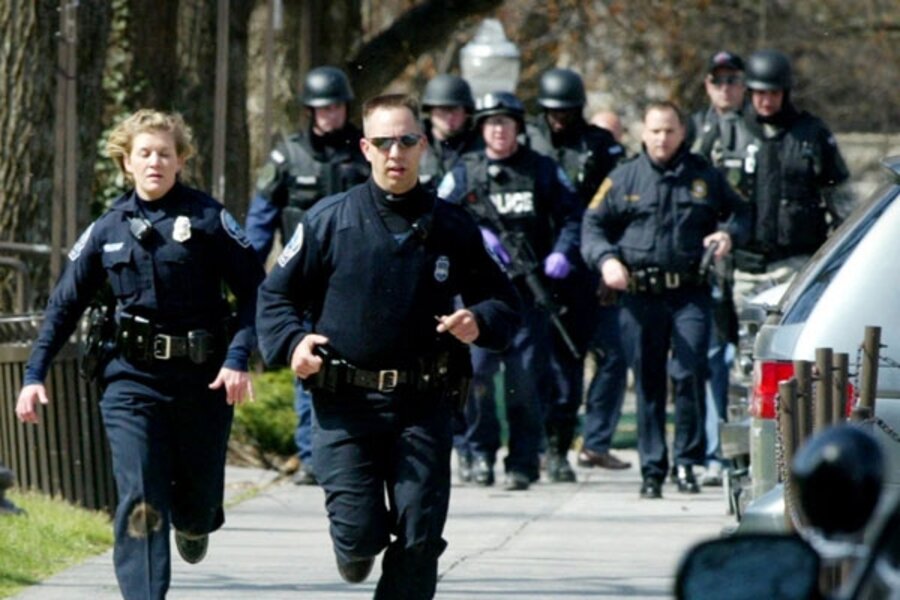Three lessons shaping society after Virginia Tech massacre
Loading...
| Atlanta
Virginia Gov. Tim Kaine said Friday that the Virginia Tech rampage that killed 32 people plus the shooter two years ago was “by its nature inexplicable.”
But no matter how tough to explain, the tragic massacre by a deranged student continues to have a significant impact on US society, ranging from debates about concealed-carry guns on campuses, police response to “active shooters,” and -- more specifically -- the question of Virginia Tech’s culpability in the deaths of students and professors at the hands of the shooter, Seung-Hui Cho.
In just the past few weeks, three developments touched directly on how the deadliest peacetime shooting in US history by a single gunman continues to spark debate and shape society:
New details anger parents
Acknowledging stubborn questions brought up by victims’ families, the state of Virginia on Friday released an addendum to the Virginia Tech Review Panel’s final report.
Basically a clarification to the original report, the correction changed the timeline of the university’s response, pointing out that university officials failed to alert the campus of a “shooter on the loose” for two hours even as they locked down university offices and at least two staffers informed their own families of the first shooting, at Ambler Johnston Hall. The new report also notes that the university cancelled trash collection 20 minutes before alerting the campus.
The addendum doesn’t change the findings of the review, which had already determined that the university’s poor response between the first shooting at Ambler Johnston Hall and the classroom shootings at Norris Hall nearly two hours later contributed to the loss of life.
But it did give vent to families who still believe that state and university officials have yet to tell the whole truth about what happened that morning, confirming, at least to some, that it is accuracy and responsibility -- not concerns about image and culpability -- that are critical to the healing process after a mass shooting.
“We still suffer emotional pain dealing with the impenetrable layers of bureaucracy in our simple quest for answers,” a statement from the victims’ families said. “An accurate, complete and thorough accounting of what happened before, during and after April 16th, 2007 is the legacy we seek on behalf of those who died and those who survived.”
All but two families accepted an $11 million settlement from the state.
University overrides students, bans guns
Despite pleas from gun rights groups and even many college students, the result of the Virginia Tech shooting has been a focus on controlling guns on campus, not allowing more students to carry.
To be sure, the Virginia Tech shooting revealed weaknesses in Virginia gun laws since they did not prevent a person with a history of psychological problems to purchase the eventual murder weapon. But others say the rampage might have been stopped had fellow students been armed.
On Friday, Colorado State University, one of the few colleges in the country to allow concealed-carry guns on campus, revealed the prevailing winds when the Board of Governors voted 9-0 to enact a policy that will likely lead to a campus gun ban, despite a student senate vote this week in support of allowing weapons at the school.
Nearly all college campuses in the US ban concealed weapons, but the debate about the wisdom of such bans intensified after the Virginia Tech rampage. Since then, proposals to lift gun bans have been raised in dozens of states, although none have been successful.
“If we wanted to ban concealed weapons because they could be dangerous, we might as well ban everything on campus because they could be a potential risk,” CSU history student Brady Allen told the Denver Post.
Fort Hood rampage tests VT’s “active shooter” legacy
The Virginia Tech Review Panel never faulted the police response in the wake of the VT shootings, writing that police responded quickly and used “appropriate active shooter procedures.”
But the official response from the Virginia State Police after Cho’s attack -- sending officers into an “active shooter” situation without a plan or backup is counterproductive -- has since been largely discredited in the law enforcement community.
After a disgruntled Army Major opened fire at Fort Hood on Nov. 5, officials credited lessons learned from the Virginia Tech shooting for ending the rampage when a civilian police officer shot and injured Nidal Malik Hasan, the alleged attacker.
“The lesson from Virginia Tech was, don’t wait for backup but move to the target and eliminate the shooter,” Chuck Medley, chief of Fort Hood’s emergency services, told the Monitor. “It requires courage and it requires skill.”
As part of the post-Virginia Tech “active shooter” response scenario, Officer Kimberly Munley was shot, and may never work a beat again because of her injuries. Officials credit her with saving “countless lives.”
-----
Follow us on Twitter.


